80% of building companies trading today will go out of business in the next 5 years.
The reasons listed are varied… cash flow, low margins, non-payment... but really, there is only one thing that causes a building company to fail…
They are not making a profit.
Pretty simple really, if you’re not making a profit each month then you are making a loss. And if you keep losing money, sooner or later your business will fail and you’ll be out of work... with a mob of angry creditors chasing personal guarantees.
And yet, despite the simplicity of this equation, over 95% of builders have no idea if they made a profit last month!
They know how much money went into the bank… But they have no idea of the gross profit, their total expenses and the net profit that was left over.
Why?
Because their financial reports make no sense... so they simply ignore them. It’s like flying a plane without any instruments, sooner or later you will crash into a mountain!
In this article, you’ll discover the difference between a Profit & Loss Statement and a Balance Sheet report. You’ll also find out how to read them, which will allow you to make better, more informed decisions for your building company…
You Need To Understand Your Company's Financial Reports
When you can read and understand the financial reports for your building company, you will make better, more informed decisions that lead to increased profits and income.
But when you ignore this stuff and rely on your accountant to provide you with figures at the end of the year, you are using outdated and incorrect information. Outdated because looking at financials from over a year ago is like knowing how much fuel you had in your car last month... it’s not helpful and it’s not relevant!
You need the financial reports for last month so that you can course correct and ensure that you make a profit this month.
The difference between a Profit & Loss Statement and a Balance Sheet
 A Profit and Loss Statement, or P and L as it’s known for short, is a record of your income and expenses for a given period of time.
A Profit and Loss Statement, or P and L as it’s known for short, is a record of your income and expenses for a given period of time.
Think of it like like putting fuel into your car. The fuel going into the tank is your income. When you fire up the engine and go on a journey you burn a percentage of that fuel, which is like your outgoings. The bit left over at the end is the net profit that you get to keep.
Your outgoings come under two categories, your cost of sale items like labour and materials to complete a home, and your expenses such as admin and marketing.
By deducting the cost of sale from your revenue, you have the gross profit, and by deducting the expenses from the gross profit you end up with the net profit.
So long as that figure is positive rather than negative, you’re doing ok! Not great, but at least you are not losing money, so that’s OK for now.
Of course, the real target is to have a net profit margin that is at least 10% of your revenue after deducting a reasonable wage for yourself in the expenses.
Getting to this stage will take strategic planning and diligent execution, but it can be done.
 Balance Sheets
Balance Sheets
When you make a profit, that profit is represented on your balance sheet as an asset. It could be cash in the bank, a fixed asset such as equipment, or even someone who owes you money; a debtor.
Take a look at your balance sheet now. At the top you’ll see a list of company assets including cash in the bank, fixed assets and current assets such as debtors.
Below the assets you’ll see a list of liabilities. These include money owed to suppliers and trades which are displayed as creditors, bank loans and other items such as tax that may be owed by the company.
If your assets are greater than your liabilities you’re doing OK… Not great, just OK. To be doing great you need to ensure that you are ‘liquid’. By that we mean you need to have the ability to pay ALL of your liabilities that are due in the next 365 days from your current assets such as cash and debtors.
Now this all sounds very simple in theory, but there is one major problem that affects building companies and throws a spanner in the works for financial reporting:
What happens when you don't have all the supplier invoices that relate to a claim?
This is the challenge builders face with their accounts!
Jobs are at different stages and invoices come in at different times,
And when you don't have all the supplier invoices that relate to a claim you’ve made, you end up with an inflated profit in the P&L and inflated assets in the balance sheet.
And then what happens when all those supplier invoices arrive the following month but you’ve not made a claim?
Now your accounts show that you’ve lost money!
Big profits one month... big losses the next!
No wonder 95% builders don’t bother looking at the financial reports in their accounts!
You Need Accurate Financial Reports Every Month
So how can you overcome this problem and generate accurate financial reports every month? Reports that clearly show how much profit you made every single month right down to the last cent?
By adding a Work In Progress Accounting Adjustment each month.
We have taught the WIPAA calculation to thousands of builders, bookkeepers, and accountants across Australia, New Zealand & North America. Including the WIPAA calculation in your accounts is the only way you can be sure that your company is making a profit each month.
If you would like to discover more about accounting and financials for a residential building company, download our free checklist for understanding construction financials.




